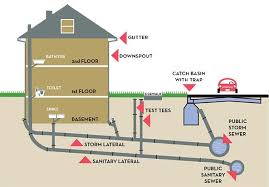Urbanization brings with it the complex challenge of managing water, both from natural sources and human activities. Two integral components of urban water management are drainage and sewerage systems. These systems work in tandem to address the diverse needs of growing cities, ensuring the efficient flow and treatment of water. In this article, we will delve into the intricacies of drainage and sewerage systems, exploring their functions, components, and the critical role they play in maintaining urban environments.
Drainage Systems:
- Purpose and Function: Drainage systems are designed to manage the excess water that accumulates due to rain, storms, or melting snow. Their primary function is to prevent waterlogging and flooding by efficiently directing surface water away from urban areas. Drainage systems help protect infrastructure, roads, and properties from water-related damage.
- Components of Drainage Systems:
- Surface Drains: These are open channels or gutters along roads and pavements designed to collect and transport surface water.
- Stormwater Drains: Underground pipes that collect and channel rainwater from streets, roofs, and other surfaces to prevent flooding.
- Detention Basins and Retention Ponds: Engineered structures that temporarily hold and manage excessive stormwater, preventing downstream flooding.
- Types of Drainage Systems:
- Surface Water Drainage: Involves the use of open channels, gutters, and stormwater drains to direct rainwater away from urban areas.
- Subsurface Drainage: Utilizes pipes or drainage tiles buried underground to remove excess groundwater and prevent soil saturation.
- Urban Planning and Design: Effective drainage is a critical consideration in urban planning and design. Properly designed drainage systems contribute to sustainable urban development, safeguarding infrastructure, and ensuring the safety and well-being of the population.
- Challenges and Innovations:
- Urbanization Impact: Rapid urbanization can strain existing drainage systems, leading to inadequate water management and increased flood risks.
- Green Infrastructure: Innovative solutions such as green roofs, permeable pavements, and rain gardens are increasingly being integrated into urban landscapes to enhance natural drainage processes and reduce runoff.
Sewerage Systems:
- Purpose and Function: Sewerage systems focus on the collection, transportation, and treatment of wastewater generated from domestic, commercial, and industrial sources. The primary goal is to safeguard public health by safely removing and treating sewage before its release into the environment.
- Components of Sewerage Systems:
- Collection Pipes: Network of pipes that collect wastewater from homes, businesses, and industries.
- Main Sewer Lines: Larger pipes that transport wastewater from collection pipes to treatment plants.
- Manholes: Access points for inspection, maintenance, and ventilation within the sewerage system.
- Treatment Plants: Facilities where wastewater undergoes various processes to remove impurities before discharge or reuse.
- Effluent Disposal/Reuse Systems: Manage the treated water, directing it to receiving water bodies or repurposing it for non-potable applications.
- Types of Sewerage Systems:
- Combined Sewerage Systems: Integrate the collection of stormwater and wastewater into a single network, directing both to centralized treatment facilities.
- Separate Sewerage Systems: Maintain distinct networks for stormwater and wastewater, each directed to its own treatment process.
- Urban Planning and Design: The design of sewerage systems is crucial for preventing environmental pollution and ensuring public health. Proximity to treatment plants, pipe material selection, and consideration of population density are all factors that influence sewerage system planning.
- Challenges and Innovations:
- Aging Infrastructure: Many cities grapple with aging sewerage infrastructure, requiring regular maintenance and upgrades.
- Smart Technologies: The implementation of smart technologies, such as sensors and real-time monitoring, enhances the efficiency of sewerage systems, allowing for proactive maintenance and improved performance.
Integrated Approach:
While drainage and sewerage systems serve distinct purposes, they are interconnected in the broader context of urban water management. A holistic and integrated approach considers the relationship between stormwater runoff and wastewater, acknowledging the impact of one system on the other.
Conclusion:
Drainage and sewerage systems are indispensable components of urban infrastructure, playing pivotal roles in managing water flow and maintaining public health. A harmonious integration of these systems, supported by innovative technologies and sustainable urban planning, is essential for creating resilient and livable cities that can withstand the challenges of a rapidly urbanizing world. The careful consideration of both natural and human-induced factors will be instrumental in developing effective strategies for urban water management in the years to come.

